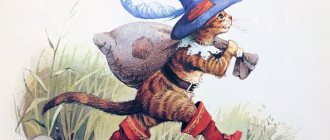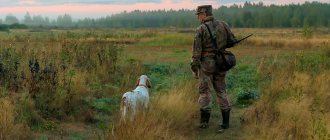- Summary
- /
- Different
- /
- Defoe - Robinson Crusoe
Year of writing: 1719 Genre: novel
Main characters: Robinson Crusoe and Friday
This work is one of the most popular in a number of English novels. It talks about the life of a sailor from York who spent 28 years on a desert island, where he ended up as a result of a shipwreck.
The theme of the work was based on the spiritual and intellectual development of a young guy who found himself in unusual living conditions. The main character has to learn to live again, make the necessary items, get food and take care of himself.
Summary of Robinson Crusoe by chapters
1. Since childhood, Robinson Crusoe dreamed of connecting his life with sea voyages, but his parents were against such a hobby for their son. But despite this, when Robinson turned 18, he took his friend and his father’s ship and they went to London.
2. Already from the first day of sailing, trouble befalls the ship; it gets caught in a storm. The main character, frightened, promises never to go to sea again and to always be on land, but as soon as the storm calmed down, Robinson forgot all his promises and gets drunk. As a result, the young crew is again overtaken by a storm and the ship sinks. Robinson is ashamed to return home and decides on new adventures.
3. Arriving in London, Crusoe met a captain who wants to take the guy with him to Guinea. Soon the old captain died, but the heroes continue their journey. So, while sailing near Africa, the ship is captured by the Turks.
Robinson Crusoe is taken prisoner for three years, after which he manages to escape by deception, taking with him the boy Xuri. Together they swim to the shore, where the roar of animals is heard; during the day they go ashore to find fresh water and also to hunt. Crusoe explores the island in hopes of finding signs of life.
4. The heroes find savages with whom they manage to make friends, so they fill the supplies of what they need. They gave the leopard to the savages as a token of gratitude. After spending some time on the island, the heroes are taken away by a Portuguese ship.
5. Robinson Crusoe lives in Brazil and grows sugar cane. There he makes new friends, to whom he tells about his travels. After some time, Robinson is offered another trip in order to obtain gold dust. And thus the team sets off from the shores of Brazil. The ship lasted 12 days during the voyage, after which it fell into a storm and sank. The crew seeks salvation on a boat, but they still go down. Only Robinson Crusoe managed to get out alive. He is glad to be saved, but still sad for his dead comrades. Crusoe spends his first night in a tree. and is engaged
6. Waking up, Robinson saw that the ship had washed much closer to the shore. The hero goes to explore the ship to find supplies of food, water and rum. To transport the things he found, Robinson builds a raft. Soon the hero realizes that he is on an island; in the distance he sees several more islands and reefs. It takes several days to transport things and build a tent. Crusoe managed to translate almost everything that was on the ship, after which a storm arose, which carried the remains of the ship to the bottom. he ended up on the island
7. Robinson Crusoe devotes the next two weeks to sorting out supplies of food and gunpowder, and then hiding them in the crevices of the mountains.
8. Robinson came up with his own calendar; a dog and two cats from the ship became his friends. He keeps a diary and writes down what happens to him and what surrounds him. All this time, the hero waits for help to come for him and therefore often falls into despair. So a year and a half passes on the island, Crusoe practically no longer expects the ship to come, so he decides to equip his place of residence as best as possible.
9. Thanks to the diary, the reader learns that the hero managed to make a shovel and dig a cellar. Crusoe hunts goats and also tames a wounded kid, and he also catches wild pigeons for food. One day he finds ears of barley and rice, which he takes for sowing. And only after four years of life, he begins to use grains as food.
10. An earthquake hits the island. Crusoe begins to get sick, he is tormented by a fever, which he treats with tobacco tincture. Soon Crusoe explores the island more carefully and finds new fruits and berries. In the depths of the island there is clean water, and so the hero establishes a dacha. In August, Robinson dries the grapes, and in the period August-October the island experiences heavy rains.
11. During heavy rains, Robinson is engaged in weaving baskets. He makes the transition to the opposite side of the island, and it turns out that living conditions there are much better.
12. Robinson continues to grow barley and rice and to scare away the birds, Robinson uses the corpses of their comrades.
13. Robinson tames a parrot and teaches him to talk, as well as learn how to make dishes from clay. For some time he learned to bake bread.
14. The hero devotes the fourth year of his stay on the island to building a boat. He also hunts animals for their skins so he can make new clothes. To protect himself from the sun's rays, Crusoe makes an umbrella.
15. It took about two years to build the boat; with its help it was possible to travel around the island. During all this time, the hero has become accustomed to the island and it already seems like home to him. Soon he managed to create a smoking pipe.
16. It was the eleventh year of Robinson’s stay on the island, by which time his supplies of gunpowder were running out. Crusoe tames goats so as not to be left without meat supplies. Soon his herd becomes larger and larger, thanks to this the main character no longer experiences a shortage of meat food.
17. One day Robinson Crusoe found someone’s print on the shore, it was clearly a person. This discovery frightens the hero, after which Robinson cannot sleep peacefully and leave his hideout. After sitting in the hut for several days, Crusoe finally went out to milk the goats and realized that the traces found were his. But carefully examining the size of the print, I realized that it was still the trace of an alien.
18. Two years have passed since Robinson Crusoe found traces on the island. One day he explored the west of the island and found a shore with human bones. After such a discovery, Crusoe does not want to explore the island anymore and is on his part, busy with home improvement.
19. Twenty-four years have passed since the main character has been on the island. And the hero notices that an unknown ship has crashed not far from the island.
20. Robinson Crusoe failed to understand whether someone from the destroyed ship survived or not. On the shore he found the body of a cabin boy, and on the ship a dog and some things.
21. Robinson Crusoe finds himself a new friend, calls him Friday, since on that day he was saved. Now the main character sews clothes and teaches Friday, thanks to this Crusoe feels less lonely and unhappy.
22. Robinson teaches Friday to eat animal meat, teaches him to eat boiled food. The savage, in turn, gets used to Robinson, tries in every possible way to help him and tells him about the island that is nearby.
23. Robinson and Friday are making a new boat to leave the island, adding a rudder and sails to it.
24. The main characters are attacked by savages, but are repulsed. Among the savages captured was a Spaniard, and also Friday's father.
25. The Spaniard helps Robinson build a ship.
26. Escape from the island is delayed due to low tide.
27. Armed people are making their way onto the island after their missing comrades. But Friday and his assistants cope with some of the attackers.
28. Robinson Crusoe gets home, where his sisters are eagerly waiting for him, to whom the protagonist will soon tell his whole story.
Rate this piece:
- 4.02
Votes: 473
Read summary Defoe - Robinson Crusoe. Brief retelling. For a reader's diary, take 5-6 sentences
What was Robinson Crusoe doing on a desert island?
Robinson Crusoe is the hero of the novels of the English writer Daniel Defoe. In his incredible adventures, by the will of fate, he finds himself thrown onto a desert island, where he will have to live for decades, all alone (alone?).
Would you like to be in the shoes of a famous hero? Then you should know that Robinson Crusoe on a desert island, in addition to the need for daily survival in the wild, received a lot of problems, including boredom and lack of normal time with people.
But daily systematic work did not allow Robinson to fall into a long depression. Of course, there were breakdowns, and sometimes the hero was overcome by despair, however, despite this, Robinson knew exactly what he needed to do. Or, at least, he guessed, based on necessity.
First of all, Robinson Crusoe had to take care of the most necessary things that helped him survive - these are, of course, firearms, gunpowder and knives to protect himself from possible predators and unexpected guests. It is worth noting that thanks to them he was able to calmly hunt animals.
After this, Robinson is engaged in arranging housing, which was supposed to protect him from predators and enemies. He sets traps, protects the dwelling, partly covered under a canvas, partly dug into the mountainside, with a palisade, and begins to take care of the third item on the agenda.
Robinson began raising domestic animals, salting meat, planting and harvesting crops, trying to bake bread, growing grapes... Robinson did not forget about traveling around his island. He never gave up hope of being delivered from the uninhabited island, which is why Robinson attempted a “circumnavigation” around the island, creating a large boat for sea travel. Robinson Crusoe even tries to leave the island on a large raft... In other words, everyday life practically nullified all attempts by Madame Depression to harm Robinson. By the way, after some time it turns out that the island is not so uninhabited.
To summarize, we can answer the question this way, doing everyday work, without giving up hope for a better future, Robinson Crusoe lived on an island, waiting for the moment when some ship passing by would pick him up and take him home.
Was the article helpful? Share!
Which Gospel was written in Aramaic?
When did the first calendar appear?
When did the game Sudoku appear?
Are there nuclear weapons in Ukraine?
Robinson, but not Crusoe. True story
Who among us did not read in childhood, either voluntarily or “under pressure” (as required by the school curriculum), Daniel Defoe’s adventure novel about Robinson Crusoe? The novel is written in the relatively rare genre of “fictional autobiography” or “Robinzoad”, so it is not surprising that the name of the main character became a household name two hundred years ago. Defoe himself wrote not one novel, but four. Moreover, the latter tells about the adventures of the already elderly Robinson in Siberia... However, the last novels in the series were never fully translated into Russian.
The adventures of Robinson and his faithful companion Friday are written so realistically that no one doubts the reality of the “autobiography”. However, alas, the real Robinson Crusoe never existed.
“Robinson” is a collective image from many stories about sailors surviving on uninhabited islands, of which there were many in that era.
The content of the article
Pirates in Her Majesty's Service
The fact is that, although Defoe avoids this topic in his novel, all (or almost all) the real prototypes of his novel were pirates . As a last resort - privateers, i.e. the same pirates, only working under a contract for one of the warring countries (most often they were used by Great Britain to rob Spanish “golden caravans”).
Since pirate ships were not equipped with guardhouses, such sailors were either killed for their misdeeds or left on a desert island “to be judged by God.” In the latter case, the islands were used as "natural prisons". Indeed, you can’t escape from such an island, and it’s not easy to survive there. This was the “divine judgment”: if after a year or a couple of years the sailor remained alive, then he was again taken away by his own “colleagues” in the pirate “workshop”, but if not... No, as they say, there is no trial.
Alexander Selkirk
It is believed that Defoe's greatest influence was the story of the survival of the Scotsman Alexander Selkirk . This was a sailor who served on the galley (small warship) Saint Port , where he was a boatswain. In 1704, as part of a small privateer flotilla under the leadership of the famous captain Dampier, he was supposed to rob Spanish ships off the coast of South America. However, like a true Scottish privateer, Selkirk had a very bad character and violent disposition, which is why he constantly quarreled with other sailors and superiors (and arguing with the pirate captain is more expensive for himself). Because of one of these quarrels, he was demoted in rank, after which he “in his hearts” declared that he now had no place on this ship. The captain took his words literally and ordered him to land on the nearest uninhabited island...
Despite the fact that the unlucky boatswain repented and asked to cancel the order, the captain equipped the sailor with everything necessary and landed him on the small island of Mas a Tierra, 600 km from the coast of Chile.
A good start to Robinson's story
It must be said that Selkirk received excellent equipment for those times. He was given spare clothes and underwear (a luxury for those times), tobacco, a cauldron for cooking, a knife and an axe. And most importantly, our hero was provided with a flintlock rifle, quite modern at that time, with a pound of gunpowder, bullets and flint. They also included the Bible, without which the “divine judgment” would not have been a trial. 300 years later, archaeologists at the site of his camp in the tropics also found navigational instruments, thanks to which Selkirk probably observed the stars, thus determining the day and month.
Let us note that the boatswain himself was an experienced man, although he was only 27 years old at the time of disembarkation. Alexander, the son of a shoemaker, ran away to a ship as a sailor at the age of 18. However, his ship was almost immediately captured by French pirates, who sold Selkirk into slavery. However, the brave young man escaped, joined the pirates himself and returned home as an experienced sailor with a large wallet full of ill-gotten gold coins...
Finding himself on a desert island, our sailor began a vigorous activity. He built an observation post and two huts: an “office” and a “kitchen”. At first he ate local fruits and roots (he found, for example, a local variety of turnip), but then he discovered a small population of goats, which he hunted with his gun. Then, when gunpowder began to run out, he tamed goats and began to receive milk, meat and skins from them. The latter came in handy when, a couple of years later, his clothes became unusable. Using a nail he found, he sewed himself simple clothes from goat skins. The experience of working in my father's shoe shop came in handy. From half a coconut I made myself a “cup” on a leg, “furniture”, etc. That is, Selkirk has settled down quite thoroughly on the island.
Preserve humanity in solitude
Alexander Selkirk never met his “Friday”, so he suffered most from loneliness. The main tests, by his own admission, were loneliness and the fight against the rats that flooded this island. The rats ate food supplies and spoiled all his other property. Selkirk even made his own chest (which he decorated with carvings) to protect things from the weather and rats.
However, the boatswain found wild cats on the island, which he tamed, and thus protected himself from tailed pests. The presence of goats, rats and feral cats indicated that the island was once inhabited, but Selkirk never found traces of other people. In order not to forget human speech, he talked to himself and read the Bible aloud. Despite the fact that the boatswain was not the most righteous person, it was the Bible, as he himself later admitted, that helped him remain human in a wild environment.
One day, two Spanish ships arrived on the island, probably in search of fresh water, but Selkirk, who was a British privateer, was afraid to go out to them because... The Spaniards would probably have hanged him on the yards for piracy. The ships left, and the boatswain was again left alone with the goats and cats.
Robinson's rescue and the end of the story
But he was still saved. Four years after he arrived on the island, on February 1, 1709, his own flotilla under the leadership of Dampier returned for Selkirk. However, its composition was already different, and the ship "Saint Port" was not there. It is noteworthy that Woods Rogers, the captain of the Duke, which was directly involved in the evacuation of the Robinson, indicated in his logbook that he was rescuing the “governor of the island.”
Once on civilized land, Alexander Selkirk became a regular at taverns, where he told stories of his adventures on a desert island over a glass of beer. Probably one of the witnesses to his drunken performances was Daniel Defoe. The Scot himself did not stay on land for long. After some time, he returned to privateering again, but ten years later, off the coast of West Africa, he died of yellow fever and was “buried at sea” (that is, thrown overboard with full honors). This is how the story of the real “Robinson” ended.
By the way, the island where Alexander Selkirk lived was called “ Robinson Crusoe ”, and the neighboring one was called “ Alexander Selkirk ”. But this happened after the inglorious death of the brave Scottish boatswain with a bad character, who died without knowing that he had become a legend.
Interesting topics
- Chekhov - Gooseberry
Two friends: Ivan Ivanovich and Burkin are taking a walk in nature. But a little rain covers them. In order not to get completely wet, the friends decide to visit a familiar landowner Alekhine. - Dumas - The Three Musketeers
The novel shows the characters of the main characters. The author shows that there is a strong friendship between them. At the same time, the musketeers have similarities and differences in their characters. - Baum - The Wizard of Oz
The world-famous stories about the magical land of Oz were created by Layman Frank Bauman. Despite significant - Lagerlöf - Nils' Wonderful Journey with the Wild Geese
Once upon a time in a small village in Sweden there lived a boy named Nils. He was lazy, he didn’t like studying, and he didn’t like helping his parents around the house. One day Nils catches a tiny gno






